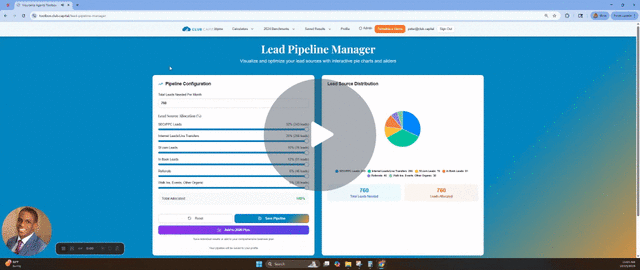Lead Pipeline Manager – Complete Guide
The Lead Pipeline Manager helps you organize, allocate, and balance leads across various sources to create a sustainable and efficient marketing strategy.
Lead Pipeline Manager Walkthrough Video - Watch Video

The Lead Pipeline Manager is a complementary tool to the Sales Goal Calculator. While the Sales Goal Calculator determines how many total leads your agency needs to reach your sales targets, the Lead Pipeline Manager helps you organize, allocate, and balance those leads across various sources — both paid and organic — to create a sustainable and efficient marketing strategy.
1. Connecting with the Sales Goal Calculator
The output from the Sales Goal Calculator provides a key number:
The total number of leads your team must work each month to achieve your production goal.
The Lead Pipeline Manager takes this figure and helps you break it down by lead source — showing where your leads are currently coming from and where additional leads will be needed to hit your targets.
2. Defining a Lead
In this context, a “lead” is defined as a qualified contact that includes:
- Name
- Phone number
- Email address
Each lead represents a potential customer who could receive an auto, home, or other policy quote during the month.
3. Entering Your Current Lead Sources
Start by entering how many leads you currently receive each month from each source. Typical sources include:
- Referrals
- In Book leads Upsells-Cross Sales
- SF.com leads
- SEO / Pay-Per-Click (PPC)
- Internet leads / Live transfers
- Walk Ins, Events, Other Organic
Once you input these values, the tool will calculate:
- How many leads you currently have
- How many additional leads are needed to reach your total goal
4. Allocating Leads Across Different Channels
After identifying the gap between your current leads and your goal, you can strategically allocate how to fill that gap.
You can explore adjustments such as:
- Encouraging more upsells and referrals from your existing client base
- Increasing investment in paid marketing channels (like PPC or live transfers)
- Boosting SEO presence for more consistent organic lead flow
This helps you see the balance between paid versus free or low-cost lead sources.
Example Scenario
Let’s say your total monthly goal is 760 leads.
Your current distribution might look like this:
- 258 leads from SEO / Pay-Per-Click
- 236 leads from Internet leads and live transfers
- The remaining 266 from referrals, events, and other organic channels
In this example, about 500 of your 760 leads are paid for, while the rest come from organic efforts.
5. Estimating Your Marketing Budget
The tool also allows you to estimate your total marketing cost.
Multiply your average cost per lead by the number of leads you’ll purchase.
For example:
- 500 paid leads × $12 per lead = $6,000 monthly marketing spend
This gives you a clearer understanding of your budget requirements and lets you compare spend-to-production efficiency across months.
6. Healthy Lead Source Distribution Guidelines
To maintain efficiency and long-term growth, it’s important to keep a balanced mix of lead sources. The Lead Pipeline Manager includes some general benchmarks:
a. Internet Leads
- Keep internet leads under 55–60% of your total monthly leads.
- Exceeding this threshold can increase your lapse rate over time due to lower retention and policy longevity.
b. SEO / PPC Leads
- Maintain at least 20% of your total leads from SEO or PPC sources.
- Falling below this level can weaken your online presence and reduce your website’s authority — which can make it harder to generate StateFarm.com and other organic leads in the future.
7. Why Lead Distribution Matters
A balanced pipeline ensures that:
- Your team has a steady flow of leads to work each month
- You diversify your acquisition costs, avoiding overreliance on any one source
- Your online visibility remains strong through consistent digital engagement
- You maintain a healthy lead-to-sale conversion rate by keeping pipelines warm and well-managed
Ultimately, the Lead Pipeline Manager helps you manage your marketing budget strategically while keeping production consistent and sustainable over time.
Summary
The Lead Pipeline Manager allows agents to:
- Visualize and balance their lead sources
- Identify gaps between current and target lead volumes
- Allocate resources between paid and organic channels
- Estimate marketing costs based on lead source mix
- Maintain healthy ratios to ensure long-term efficiency and online strength
By using the Lead Pipeline Manager alongside the Sales Goal Calculator, agencies can make informed decisions about marketing spend, lead sourcing, and overall sales efficiency — keeping both production and profitability aligned with their growth goals.